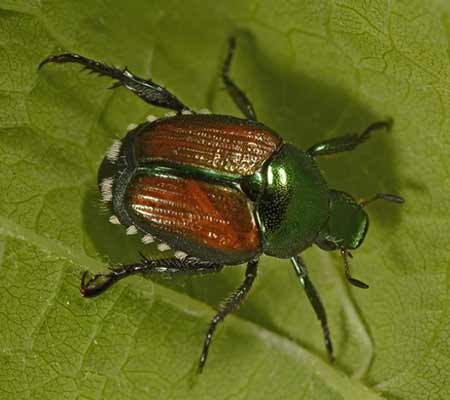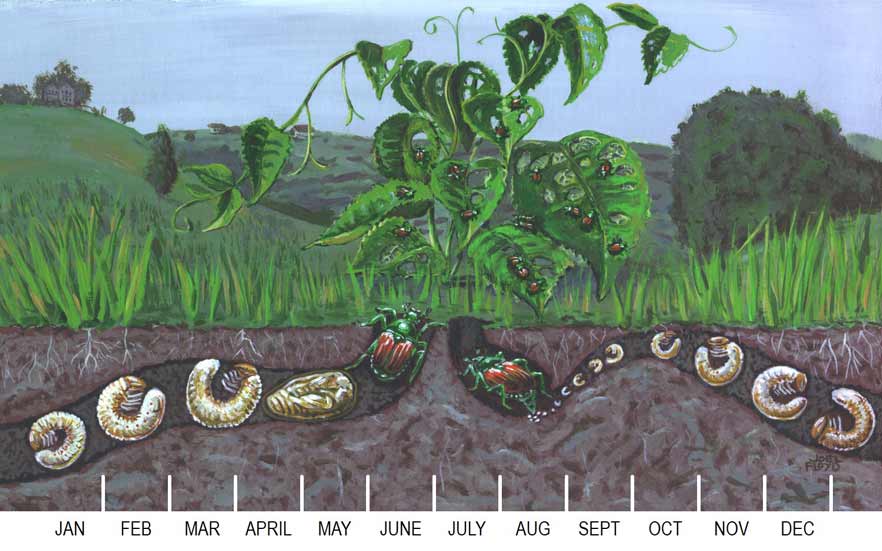Japanese beetle were accidentally introduced from Asia to the eastern United States in 1916. Since then, they have established populations in 28 states with detections in an additional 13, becoming a primary insect pest species in many agricultural systems. Japanese beetle feed on over 300 different plant species including fruits, vegetables, field crops, ornamentals, turf grass roots, and numerous wild plant species.
Identification
 Figure 1. Japanese beetle adult. (Joseph Berger, Bugwood.org)
Figure 1. Japanese beetle adult. (Joseph Berger, Bugwood.org)
Adult beetles are metallic green, with brown wings (approximately 5–7 mm wide and 8–11 mm long) (Figure 1). Japanese beetle are distinguished from native beetles by the presence of five pairs of white tufts on their abdominal sides and two additional tufts on the abdomen tip.
Life cycle
Japanese beetle have one generation per year (Figure 2). Adults begin to emerge in May and feed on foliage through September. Females lay eggs in soil that hatch within seven to 14 days, and grubs begin feeding on grass roots. Grubs cease feeding in October and overwinter 15 cm below the soil surface (Figure 3). Overwintering grubs move to deeper soil when winter temperatures drop below 8.6 degrees F (-13 degrees C). Grubs begin feeding again in spring after soil temperatures reach 50 degress F (10 degrees C), then pupate, and emerge as adults.

Figure 2. The Japanese beetle life cycle. (Joel Floyd)
 Figure 3. Japanese beetle grub. (David Cappaert, Bugwood.org)
Figure 3. Japanese beetle grub. (David Cappaert, Bugwood.org)
Plant damage
 Figure 4. Skeletonization by Japanese beetle on bean leaves. (Bruce Watt, University of Maine, Bugwood.org)
Figure 4. Skeletonization by Japanese beetle on bean leaves. (Bruce Watt, University of Maine, Bugwood.org)
 Figure 5. Japanese beetle feeding on corn tassels. (Daren Mueller, Iowa State University, Bugwood.org)
Figure 5. Japanese beetle feeding on corn tassels. (Daren Mueller, Iowa State University, Bugwood.org)
In soybean, Japanese beetle reduce yield through intense defoliation (Figure 4), whereas in corn, they consume tassels, decreasing pollination and ear fill
(Figure 5). Adults also feed directly on fruit commodities such as cherry, peach, plum, and blueberry, reducing fruit quality. Japanese beetle prefer plants in direct sunlight, feeding on upper foliage. Adults produce an aggregation pheromone, resulting in clumped distributions throughout fields. In turf systems, grub feeding on grass roots can create economic damage.
Management options
Commercial
Trapping: Several bag and bucket traps are commercially available that attract and capture adult Japanese beetle using pheromone lures; however, these traps are not recommended for management because they attract more beetles towards traps than they capture, leading to increased plant damage where traps are deployed.
Biological control: Several biological control agents attack Japanese beetle adults and grubs. Two parasitic wasp species, Tiphia vernalis and Tiphia popillavora kill grubs, and a parasitic fly, Istocheta aldrichi, kills adults. Milky disease is a soil bacterium that kills grubs and is commercially available. However, milky disease takes several years to establish sufficient levels for grub suppression and its efficacy is highly variable. Nematodes are also commercially available for grub control, although, they are not effective at reducing damage from beetles emerging from adjacent habitats.
Chemical control: Thresholds have been established for Japanese beetle in several field crops. In soybean, chemical control is justified when plants experience 30% defoliation during vegetative growth and 20% during reproductive growth. In corn, insecticide applications are warranted when silks have been clipped to 0.5 inches, there are an average of three to five beetles on all corn ears, and pollination is less than 50% complete. Should chemical treatment be needed, consult the local extension office and follow label instructions.
Homeowners
Mechanical control: Daily hand removal of beetles from plants into buckets of soapy water can reduce damage.
Physical control: Place screens/netting over plants after pollination is complete.
Chemical control: While chemicals are frequently applied to reduce beetle damage, they do not prevent additional beetles from reinfesting plants. If using insecticides, contact your local extension office and follow the label instructions.